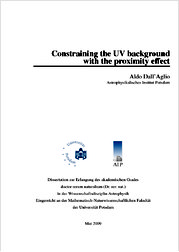| dc.contributor.author | Dall'Aglio, Aldo | |
| dc.date.accessioned | 2010-10-12T18:22:41Z | |
| dc.date.available | 2010-10-12T18:22:41Z | |
| dc.date.issued | 2009 | |
| dc.identifier.uri | http://hdl.handle.net/11858/00-1735-0000-0001-3093-9 | |
| dc.description.abstract | After the epoch of reionisation the intergalactic medium (IGM) is kept at a high photoionisation level by the cosmic UV background radiation field. Primarily composed of the integrated contribution of quasars and young star forming galaxies, its intensity is subject to spatial and temporal fluctuations. In particular in the vicinity of luminous quasars, the UV radiation intensity grows by several orders of magnitude. Due to an enhanced UV radiation up to a few Mpc from the quasar, the ionised hydrogen fraction significantly increases and becomes visible as a reduced level of absorption in the HI Lyman alpha (Ly-alpha) forest. This phenomenon is known as the proximity effect and it is the main focus of this thesis ... | |
| dc.format.extent | 94 S. | |
| dc.format.mimetype | application/pdf | |
| dc.language.iso | deu | |
| dc.publisher | Univ. Potsdam | |
| dc.rights.uri | http://e-docs.geo-leo.de/rights | |
| dc.subject.ddc | 523 | |
| dc.subject.gok | TBI 000 | |
| dc.title | Constraining the UV background with the proximity effect | |
| dc.type | monograph | |
| dc.subject.gokverbal | Ultraviolett-Astronomie | |
| dc.identifier.doi | 10.23689/fidgeo-18 | |
| dc.identifier.ppn | 616119372 | |
| dc.identifier.urn | urn:nbn:de:kobv:517-opus-38713 | |
| dc.type.version | publishedVersion | |
| dc.relation.collection | Astronomie, Astrophysik, Weltraumforschung | |
| dc.description.type | thesis | |


